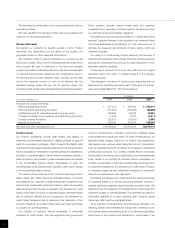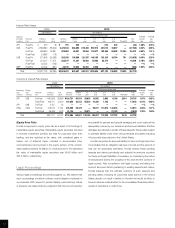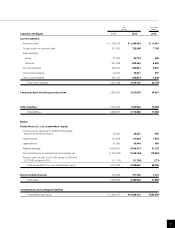Honda 2010 Annual Report Download - page 50
Download and view the complete annual report
Please find page 50 of the 2010 Honda annual report below. You can navigate through the pages in the report by either clicking on the pages listed below, or by using the keyword search tool below to find specific information within the annual report.
(Fiscal Year 2010 Compared with Fiscal Year 2009)
The provision for credit losses on finance receivables decreased by
¥22.4 billion, or 45%, and net charge-offs decreased by ¥15.5
billion, or 35%. Impairment losses on operating leases due to early
termination decreased by ¥5.4 billion, or 62%. The declines in losses
and delinquencies reflect the improvement in the overall credit quality
of our North American portfolio as a result of stricter purchasing
standards implemented in prior years, focused collection efforts,
stabilization of the economy, and improvements in used vehicle
prices.
(Losses on Lease Residual Values)
Our finance subsidiaries in North America establish contract residual
values of lease vehicles at lease inception based on expectations of
future used vehicle values, taking into consideration external industry
data. End-customers of leased vehicles typically have an option to
buy the leased vehicle for the contractual residual value of the vehicle
or to return the vehicle to our finance subsidiaries through the dealer
at the end of the lease term. Likewise, dealers have the option to
buy the vehicle returned by the customer or to return the vehicle to
our finance subsidiaries. The likelihood that the leased vehicle will be
purchased varies depending on the difference between the
contractual residual value and the actual market value of the vehicle
at the end of the lease term. We are exposed to risk of loss on the
disposition of returned lease vehicles when the proceeds from the
sale of the vehicles are less than the contractual residual values at
the end of the lease term. For direct financing leases, our finance
subsidiaries in North America purchase insurance to cover a portion
of the estimated residual value.
Our finance subsidiaries in North America have historically
accounted for all leases as direct financing leases. However, starting
in the fiscal year ended March 31, 2007, some of the leases which
do not qualify for direct financing leases accounting treatment are
accounted for as operating leases.
We periodically review the estimate of residual values. For vehicle
leases accounted for as operating leases, the adjustments to
estimated residual values result in changes to the remaining
depreciation expense to be recognized prospectively on a straight-
line basis over the remaining term of the lease.
For vehicle leases accounted for as direct financing leases,
downward adjustments are made for declines in estimated residual
values that are deemed to be other-than-temporary. The adjustments
on the uninsured portion of the vehicle’s residual value are recognized
as a loss in the period in which the estimate changed.
The primary components in estimating losses on lease residual
values are the expected frequency of returns, or the percentage of
leased vehicles we expect to be returned by customers at the end
of the lease term, and the expected loss severity, or the expected
difference between the residual value and the amount we receive
through sales of returned vehicles plus proceeds from insurance, if
any. We estimate losses on lease residual values by evaluating
several different factors, including trends in historical and projected
used vehicle values and general economic measures.
We also test our operating leases for impairment whenever events
or changes in circumstances indicate that their carrying values may
not be recoverable.
Recoverability of operating leases to be held is measured by a
comparison of the carrying amount of operating leases to future net
cash flows (undiscounted and without interest charges) expected to
be generated by the operating leases. If such operating leases are
considered to be impaired, impairment losses to be recognized is
measured by the amount by which the carrying amount of the
operating leases exceeds the estimated fair value of the operating
leases.
We believe that our estimated losses on lease residual values and
impairment losses is a “critical accounting estimate” because it is
highly susceptible to market volatility and requires us to make
assumptions about future economic trends and lease residual
values, which are inherently uncertain. We believe that the
assumptions used are appropriate. However, actual losses incurred
may differ from original estimates as a result of actual results varying
from those assumed in our estimates as a result of actual results
varying from those assumed in our estimates.
If future auction values for all Honda and Acura vehicles in our
North American operating lease portfolio as of March 31, 2010,
were to decrease by approximately ¥10,000 per unit from our
present estimates, holding all other assumptions constant, the total
impact would be an increase in depreciation expense by
approximately ¥2.3 billion, which would be recognized over the
remaining lease terms. Similarly, if future return rates for our existing
portfolio of all Honda and Acura vehicles were to increase by one
percentage point from our present estimates, the total impact would
be an increase in depreciation expense by approximately ¥0.5
billion, which would be recognized over the remaining lease terms.
With the same prerequisites shown above, the impacts to the direct
financing lease portfolio would be an increase in losses on lease
residual values by approximately ¥0.3 billion and ¥0.2 billion. Note
that this sensitivity analysis may be asymmetric, and are specific to
the base conditions in fiscal 2010. Also, declines in auction values
are likely to have a negative effect on return rates which could affect
the sensitivities.
(Fiscal Year 2010 Compared with Fiscal Year 2009)
During fiscal year 2010, used vehicle prices recovered from the
severe declines that were experienced in prior years. The improve-
ment in prices was attributable in part to lower used vehicle supplies
and stabilization in the economy during the year. No impairment
losses as a result of declines in estimated residual values were
recognized during fiscal year 2010.
Incremental depreciation on operating leases due to the declines
in estimated residual values increased by ¥0.6 billion, or 5%. Losses
on lease residual values declined by ¥15.8 billion, or 69%, primarily
due to the declines in direct financing leases.
48
























